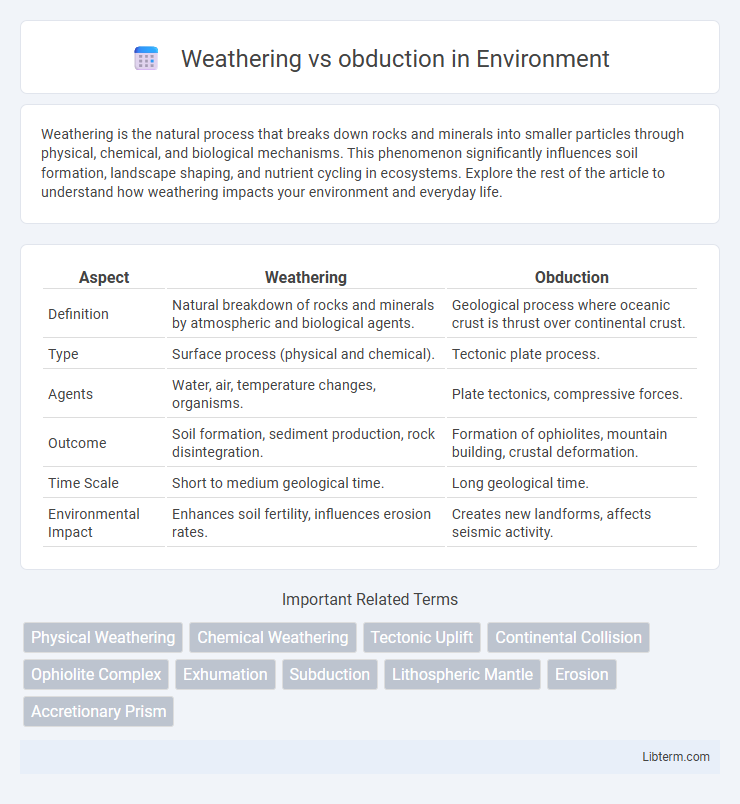Weathering is the natural process that breaks down rocks and minerals into smaller particles through physical, chemical, and biological mechanisms. This phenomenon significantly influences soil formation, landscape shaping, and nutrient cycling in ecosystems. Explore the rest of the article to understand how weathering impacts your environment and everyday life.
Table of Comparison
| Aspect | Weathering | Obduction |
|---|---|---|
| Definition | Natural breakdown of rocks and minerals by atmospheric and biological agents. | Geological process where oceanic crust is thrust over continental crust. |
| Type | Surface process (physical and chemical). | Tectonic plate process. |
| Agents | Water, air, temperature changes, organisms. | Plate tectonics, compressive forces. |
| Outcome | Soil formation, sediment production, rock disintegration. | Formation of ophiolites, mountain building, crustal deformation. |
| Time Scale | Short to medium geological time. | Long geological time. |
| Environmental Impact | Enhances soil fertility, influences erosion rates. | Creates new landforms, affects seismic activity. |
Introduction to Weathering and Obduction
Weathering is the natural process of breaking down rocks and minerals at Earth's surface through physical, chemical, and biological mechanisms. Obduction involves the overthrusting of oceanic lithosphere onto continental crust during tectonic plate collisions, contrasting with subduction where oceanic plates sink beneath continents. Understanding these processes is essential for interpreting geological formations and surface landscape evolution.
Defining Weathering: Types and Processes
Weathering involves the physical, chemical, and biological breakdown of rocks at or near the Earth's surface, enhancing soil formation and nutrient cycling. Mechanical weathering includes processes like frost wedging and thermal expansion that physically fragment rocks, while chemical weathering involves reactions such as hydrolysis, oxidation, and carbonation that alter mineral composition. Biological weathering occurs when organisms, like plant roots and microbes, disrupt rock structures, accelerating decomposition and enriching the environment.
What is Obduction? Geological Overview
Obduction is a geological process where oceanic lithosphere is thrust onto the edge of a continental plate, contrasting the more common subduction where it sinks beneath. This tectonic mechanism plays a crucial role in the formation of ophiolites and the complex structure of mountain belts such as the Alps and Himalayas. Understanding obduction provides insight into plate boundary interactions and the recycling of Earth's crust, differing fundamentally from surface-driven weathering processes that break down rocks chemically or physically.
Key Differences Between Weathering and Obduction
Weathering involves the breakdown of rocks and minerals at Earth's surface through chemical, physical, or biological processes, leading to soil formation and sediment production. Obduction refers to the geological process where oceanic crust is thrust over continental crust during tectonic plate convergence, resulting in the emplacement of ophiolites. The key difference lies in weathering being a surface-driven decomposition process, whereas obduction is a large-scale tectonic mechanism that displaces crustal plates.
Weathering Mechanisms: Physical and Chemical
Weathering mechanisms involve physical processes such as freeze-thaw cycles, thermal expansion, and abrasion that break down rocks into smaller particles without changing their chemical composition. Chemical weathering includes reactions like hydrolysis, oxidation, and carbonation that alter the mineral structure of rocks, leading to decomposition and formation of secondary minerals. These weathering processes are distinct from obduction, which refers to the tectonic emplacement of oceanic lithosphere onto continental crust.
Geological Significance of Obduction Events
Obduction events play a crucial geological role by transporting slices of oceanic crust and upper mantle onto continental margins, forming ophiolites that provide direct evidence of plate tectonic processes. Unlike weathering, which alters rocks at Earth's surface through chemical and physical breakdown, obduction preserves deep-sea lithologies in supracrustal settings, enabling studies of mantle-crust interactions and paleoenvironmental reconstructions. These tectonic episodes contribute to mountain building, crustal accretion, and the recycling of oceanic lithosphere, significantly shaping Earth's lithosphere evolution.
Impact of Weathering on Earth's Surface
Weathering significantly alters Earth's surface by breaking down rocks into smaller particles, facilitating soil formation and nutrient cycling essential for ecosystems. This process influences landscape development, erosion rates, and sediment transport, shaping mountains, valleys, and coastal features over time. Unlike obduction, which involves tectonic plate movements and the emplacement of oceanic crust onto continental margins, weathering directly transforms surface materials through physical, chemical, and biological mechanisms.
Obduction in Plate Tectonics Context
Obduction is a geological process where oceanic crust is thrust over continental crust during plate tectonic convergence, contrasting with the more common subduction where oceanic crust sinks beneath continental plates. This phenomenon plays a crucial role in the formation of ophiolites, which are slices of oceanic lithosphere emplaced onto continents, providing valuable insights into mantle and crustal composition. Unlike weathering, which involves the chemical and physical breakdown of rocks at the Earth's surface, obduction directly impacts tectonic plate configuration and continental growth.
Real-World Examples: Weathering vs Obduction
Weathering is exemplified by the gradual breakdown of the Great Sphinx of Giza due to wind and sand erosion, while obduction is demonstrated by the Oman Ophiolite, where oceanic crust has been thrust onto continental lithosphere. The Appalachian Mountains also show evidence of obduction, as fragments of ancient seafloor were pushed over continental rocks during tectonic collisions. Understanding these examples highlights the contrasting processes of surface chemical and physical breakdown versus tectonic plate-driven emplacement of oceanic materials onto continents.
Conclusion: The Interplay of Weathering and Obduction
Weathering and obduction represent critical geological processes that shape Earth's surface and crustal dynamics. Weathering breaks down rocks through chemical, physical, and biological interactions, influencing soil formation and nutrient cycles, while obduction involves the overthrusting of oceanic lithosphere onto continental margins, significantly contributing to orogenic belt development. Their interplay controls landscape evolution, tectonic activity, and mineral distribution, highlighting the complex interactions between surface processes and deep Earth mechanisms.
Weathering Infographic

 libterm.com
libterm.com